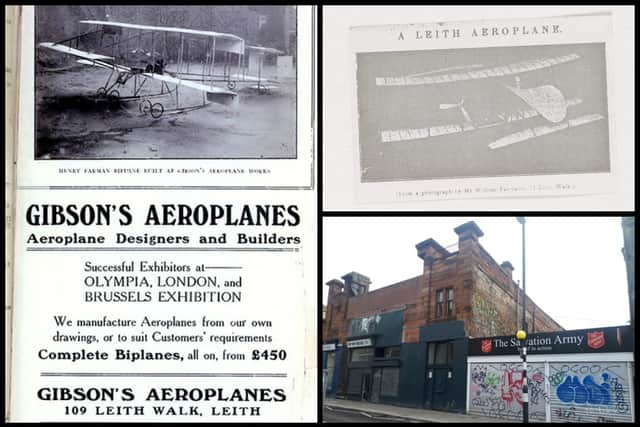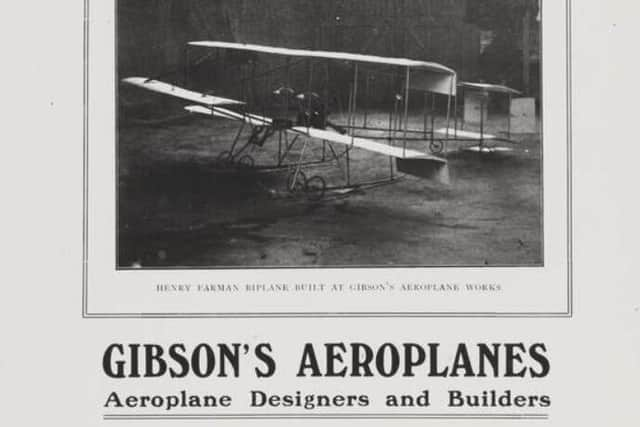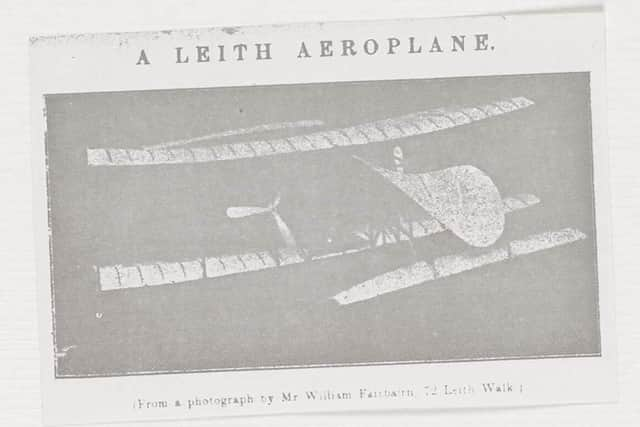The Leith Walk shop that made and sold aeroplanes
and live on Freeview channel 276
At the very dawn of manned flight one Leith Walk shop was taking a leaf out of the Wright brothers' manual and aiming for the skies.
For a short, four-year spell just before the advent of World War One, a Leith cycle makers turned its attentions to designing and building aeroplanes.
Advertisement
Hide AdAdvertisement
Hide AdBased at 109 Leith Walk, John Gibson's Caledonian Cycle Works began manufacturing biplanes in 1910, enjoying notable success with their Henri Farman models.


One of a small but fast-growing band of plane manufacturers in the world at the time, the aeroplane designers and builders supplied "Scottish-built planes" and spare parts to those who could afford it.
Manufactured from Gibson's own drawings, or to suit customers' requirements, prices for the Leith-built flying machines started at £450 - more than £50,000 when adjusted for inflation.
Gibson, who had been running a bicycle business for a number of years, developed a fascination with aeroplanes at a time when the Wright brothers - the men credited with flying the world's first successful motor-operated aircraft - were still chasing US government approval.
Advertisement
Hide AdAdvertisement
Hide AdIn 1909 the innovative cycle maker began testing numerous biplane prototypes in Leith Links, with the Leith Observer of October 9 reporting that Mr Gibson had manufactured his nineteenth model.


"Mr John Gibson, Caledonian Cycle Works, Leith Walk, has made a model aeroplane of one-fourth of the real size," the newspaper reported. "It is on view in his motor garage in Manderston Street".
Dubbed "The Big Gibson Aeroplane", the cutting edge scale models were exhibited the following year, with one biplane used as a main attraction at Edinburgh department store Patrick Thomson's Christmas bazaar in December 1910.
But John Gibson didn't just manufacture scale models, soon the Leith entrepreneur was selling full-sized, state-of-the-art aeroplanes.
Henri Farman models


Advertisement
Hide AdAdvertisement
Hide AdAdvertisements from the 1910 Edinburgh & Leith post office directory show John Gibson was selling the Farman biplane, designed by the famous aviation pioneer Henri Farman.
One of the first Europeans to fly, Farman had made a name for himself by setting an impressive number of official aviation records for both distance and duration.
The Anglo-French aviator's models were favoured by the likes of the inventor Thomas Edison, who noted that Farman's aeroplanes were superior to those designed by the Wright brothers.
Edison said the model debuted by his fellow Americans depended too much on the "personal equation" - set another man to work it and he would fail.
Advertisement
Hide AdAdvertisement
Hide AdGibson's works, contained within one of the spacious railway arches at 10 Manderston Street, would manufacture the plane parts then take out by cycle to a facility in Balerno where the planes would be assembled.
Keith Davis, a postcard collector and dealer from Fife, recalled how his father used to work for the firm in its heyday. He shared some of what he had learned from his father of John Gibson's on Peter Stubbs' Edinphoto website in 2014.
He wrote: "On one occasion, Gibson's could not find a suitable material for covering a plane's wings, so they used paper. The plane was destroyed when it caught fire.
"At one time a propeller from one of the Gibson planes was on display in their office in Leith. This was subsequently given to the Museum of Flight and is now part of their collection at East Fortune."
Advertisement
Hide AdAdvertisement
Hide AdJohn Gibson had ceased manufacturing aeroplanes just a few short months shy of the outbreak of the First World War. The cycle making business was relocated to Dalry Road in 1916.
A charity shop run by the Salvation Army occupies 109 Leith Walk today, offering scant evidence of the aeroplane manufacturers housed at the site more than a century ago.
A message from the Editor:
Thank you for reading this story on our website. While I have your attention, I also have an important request to make of you.
The dramatic events of 2020 are having a major impact on many of our advertisers - and consequently the revenue we receive. We are now more reliant than ever on you taking out a digital subscription to support our journalism.
Advertisement
Hide AdAdvertisement
Hide AdSubscribe to scotsman.com and enjoy unlimited access to Scottish news and information online and on our app. Visit https://www.scotsman.com/subscriptions now to sign up.
By supporting us, we are able to support you in providing trusted, fact-checked content for this website.
Joy Yates
Editorial Director
Comment Guidelines
National World encourages reader discussion on our stories. User feedback, insights and back-and-forth exchanges add a rich layer of context to reporting. Please review our Community Guidelines before commenting.